Caryn

 My niece, Dustie Masterson has had a very busy year. She is the assistant manager of Walgreen’s in Casper, and she has been taking college classes to better herself for her job and future positions within Walgreen’s. My nephew, Rob Masterson is so very proud of his wife, and he couldn’t wait to tell me that she is now a certified pharmacy tech in Wyoming. When she is finished with her classes, she will be certified nationwide. She is also certified to give immunizations. These are big steps toward managership within Walgreen’s. Even with her classes, Dustie spends a lot of time at Walgreen’s. I know that makes sense, since she is assistant manager, but to me she is almost a fixture. Every time I am there, Dustie is there. She is very dedicated.
My niece, Dustie Masterson has had a very busy year. She is the assistant manager of Walgreen’s in Casper, and she has been taking college classes to better herself for her job and future positions within Walgreen’s. My nephew, Rob Masterson is so very proud of his wife, and he couldn’t wait to tell me that she is now a certified pharmacy tech in Wyoming. When she is finished with her classes, she will be certified nationwide. She is also certified to give immunizations. These are big steps toward managership within Walgreen’s. Even with her classes, Dustie spends a lot of time at Walgreen’s. I know that makes sense, since she is assistant manager, but to me she is almost a fixture. Every time I am there, Dustie is there. She is very dedicated.
While her job takes a lot of her time, Dustie is, first and foremost, a wife and mother. He oldest daughter, Raelynn says, “I love every part of my mom. This year has been a rollercoaster for everyone, but especially her. Still, she hasn’t given up on what she wants to get done. When she was diagnosed with diabetes, she had a small cry and has taken care to change her entire diet to manage it, rather than just take meds to manage it like everyone else she knows with it. She’s one of the strongest people I know. One of my favorite things about her is that she doesn’t let anything hold her down. She’s going to be 80 and old and still doing silly dances to her favorite songs. She’s been working on getting certified to work in the pharmacy at her store, so they can 
 have the extra back up if they need it, on top of being a go to for almost anyone who needs help. My mom hasn’t let this hard year get to her and has taken it all in stride. I couldn’t be more proud to call myself her daughter.” That says it all, Raelynn. I know she is proud of you too
have the extra back up if they need it, on top of being a go to for almost anyone who needs help. My mom hasn’t let this hard year get to her and has taken it all in stride. I couldn’t be more proud to call myself her daughter.” That says it all, Raelynn. I know she is proud of you too
Dustie’s son, Matt says, “My mom is literally my best friend. She makes it hard not to enjoy life. She turns bad days to good ones and her cooking is to die for!! She’s also a little crazy, but what mom isn’t after four kids.” Well said Matt. Nothing wrong with a little crazy.
Dustie’s daughter, Taylor says, “My mom is one of my best friends, she’s the one I tell everything to, with full confidence that she won’t judge or tell anyone about it unless I tell her she can. Mom is a huge role model for me and how she carries herself anywhere is how I want to handle myself too. My mother is the funniest person I know, just the other day she made me laugh uncontrollably because she said, ‘Someone should make a musical about the trials and tribulations of rode construction’ when I was showing her a new musical I like. She likes to say she’s fun sized instead of short and will always get pretend defensive when we call her short. Mom is an amazing cook too!! Whatever it is, she makes I try and almost always love it. I really think she should open a restaurant with Uncle Steve (Spethman), and it would do amazingly well. I love my mother so very 
 much and I really can’t find the words to explain all of it.” Taylor, I think you did just fine.
much and I really can’t find the words to explain all of it.” Taylor, I think you did just fine.
Sometimes, I almost feel like I have a “ghost writer.” When those who provide ideas say things in such a way that there is no improving on what they have sent me, all I can do is leave it alone. Dustie is very loved by her family. She gives of herself to any in need. She is very blessed, and she is a blessing to many. Today is Dustie’s birthday. Happy birthday Dustie!! Have a great day!! We love you!!
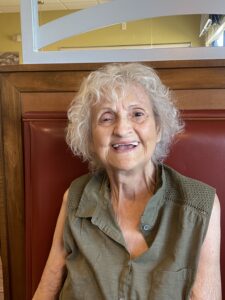

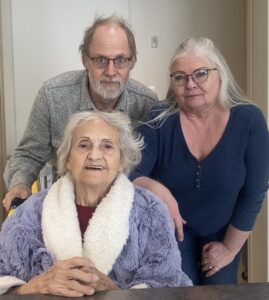 My aunt, Sandy Pattan has had what many people would call…an awful year, but because of her faith and the faith of many people praying diligently for her, she has come out of it with a year of miracles. Aunt Sandy’s “year of miracles” began with a bleeding ulcer. She was on blood thinners, and for her, that is just not the best idea. She had a procedure to cauterize the bleeder, and the ulcer stopped bleeding. It was shortly after that procedure that I came into the picture, but this isn’t about me…this is about Aunt Sandy and her amazing year.
My aunt, Sandy Pattan has had what many people would call…an awful year, but because of her faith and the faith of many people praying diligently for her, she has come out of it with a year of miracles. Aunt Sandy’s “year of miracles” began with a bleeding ulcer. She was on blood thinners, and for her, that is just not the best idea. She had a procedure to cauterize the bleeder, and the ulcer stopped bleeding. It was shortly after that procedure that I came into the picture, but this isn’t about me…this is about Aunt Sandy and her amazing year.
We went to see the doctor, and it was decided that it would benefit Aunt Sandy to have a heart monitor in place so we could see what needed to be done next. On January 26th, she called me to ask why I hadn’t come over that day. I told her I wasn’t supposed to come that day, but rather the next day. She told me that she had been a little dizzy, and she was slurring her words. I said, “Oh my gosh!! I’m on my way.” She, in true Aunt Sandy style told me it wasn’t really necessary, but I knew that it was. I have never been the one to “diagnose” a stroke, but thanks to my daughter, Corrie Petersen’s nursing school classes, when she often told me about as a means of studying, I knew about FAST…the stroke diagnosis test. I quickly ran it on Aunt Sandy and called for an ambulance. Aunt Sandy’s outcome was miraculous, not because of me, but because of God. I have no doubt. She has no significant continuing symptoms, and the neurologist has completely released her.
She had to go back on Eliquis, because while they were planning to put in a Watchman device, they found a clot in her heart. It was not what we had hoped for, but it couldn’t be helped. They could not install the device until the clot was dissolved, because if they bumped it during the procedure, it would explode and cause more strokes. I would love to say that after a standard wait time, the Watchman was successfully implanted in a “happily ever after” moment, but that wasn’t exactly how things went.
The middle of February found Aunt Sandy with a swollen right knee that was extremely painful. Initially 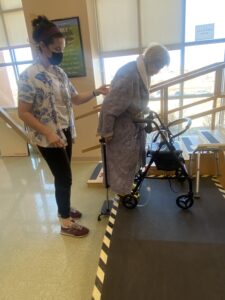
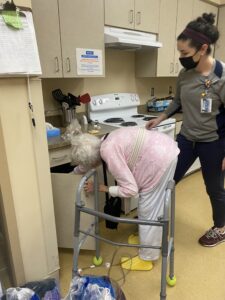
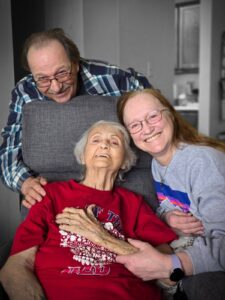 diagnosed as a Baker Cyst, we were told that it would eventually shrink on its own. Again, not the case. By February 28th, her right knee was extremely bruised and swollen to the point of blistering and splitting open. She was again taken to the hospital, where the vascular surgeon found a bleed in the knee. After a blood transfusion, she was rushed to surgery with an extremely low hemoglobin of four (normal levels are between 12 and 16), and the race was on to save her leg. Dr Kaslow did save her leg, and after three months on a wound vac, followed by a skin graft, she is doing very well from that. We are thankful to God for putting Dr Kaslow there and for the miracle of again saving her life. After a little more than two week stay at Elkhorn Valley Rehabilitation Hospital, during which Aunt Sandy received excellent care (including having them catch and deal with another bleed in her right leg), and physical therapy, she was able to go back home. Healthy and grateful both the Elkhorn’s wonderful staff and to God!!
diagnosed as a Baker Cyst, we were told that it would eventually shrink on its own. Again, not the case. By February 28th, her right knee was extremely bruised and swollen to the point of blistering and splitting open. She was again taken to the hospital, where the vascular surgeon found a bleed in the knee. After a blood transfusion, she was rushed to surgery with an extremely low hemoglobin of four (normal levels are between 12 and 16), and the race was on to save her leg. Dr Kaslow did save her leg, and after three months on a wound vac, followed by a skin graft, she is doing very well from that. We are thankful to God for putting Dr Kaslow there and for the miracle of again saving her life. After a little more than two week stay at Elkhorn Valley Rehabilitation Hospital, during which Aunt Sandy received excellent care (including having them catch and deal with another bleed in her right leg), and physical therapy, she was able to go back home. Healthy and grateful both the Elkhorn’s wonderful staff and to God!!
During her recuperation from the skin graft, Aunt Sandy’s cataracts decided that their time had come. I took her in for an eye exam, but we were told that glasses wouldn’t help. So, surgery was scheduled, and by the middle of August, she had new lenses in her eyes. Now, it was finally time to get the Watchman device. We were told all the possible outcomes and had all the tests done. She went in for the surgery on September 19th, and when it was over, Dr Fluture came out and told me that he was at the point of thinking it would not work, because she is very small. The probe seemed to be stuck halfway across the chest. Then, another miracle from God. Suddenly, the probe popped through and they were in. The rest of the procedure went as smooth as silk, and then it was in place. Praise God!! Now, she will have about six more months on a blood thinner (Plavix), and then, if all is good, she will be off of them for good.
Aunt Sandy has no doubt in her mind that she is alive today because of the incredible grace and power of God. 
 I agree. With her double knee replacement surgeries, the repair of the bleeding ulcer, cataract surgeries, and now the Watchman device, I like to tell her that she is now “fully bionic” Aunt Sandy!! To that she just laughs. She might laugh, but when you think about it, she really is. It’s been one wild year, but Aunt Sandy is a fighter, and God had her back!! Today is Aunt Sandy’s 79th birthday!! It’s an age she wasn’t sure she was going to reach, but praise God…she has!! Happy birthday Aunt Sandy!! Have a great day!! We love you!!
I agree. With her double knee replacement surgeries, the repair of the bleeding ulcer, cataract surgeries, and now the Watchman device, I like to tell her that she is now “fully bionic” Aunt Sandy!! To that she just laughs. She might laugh, but when you think about it, she really is. It’s been one wild year, but Aunt Sandy is a fighter, and God had her back!! Today is Aunt Sandy’s 79th birthday!! It’s an age she wasn’t sure she was going to reach, but praise God…she has!! Happy birthday Aunt Sandy!! Have a great day!! We love you!!

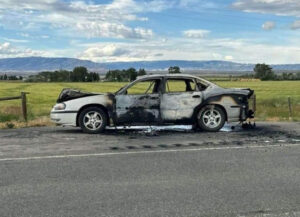 My nephew, Tucker Schulenberg has had a year beyond belief. The year started off good. Tucker was in school and had a girlfriend. He was a happy uncle his nieces and nephews. Life was getting better every day. Things had been really hard for Tucker since his mom, Rachel Schulenberg passed away on January 19, 2021, following a massive stroke. Tucker was in a really dark place for a while, but he was finally on the way out of it. He will never get over his mother’s loss, but he was healing.
My nephew, Tucker Schulenberg has had a year beyond belief. The year started off good. Tucker was in school and had a girlfriend. He was a happy uncle his nieces and nephews. Life was getting better every day. Things had been really hard for Tucker since his mom, Rachel Schulenberg passed away on January 19, 2021, following a massive stroke. Tucker was in a really dark place for a while, but he was finally on the way out of it. He will never get over his mother’s loss, but he was healing.
Then, came July 4, 2024. Tucker, his brother, Riley Birky and a couple of friends were picking up fireworks for the Independence Day celebration. Someone, no one knows who, lit a cigarette without thinking, and suddenly, 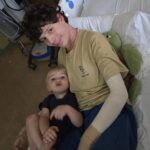
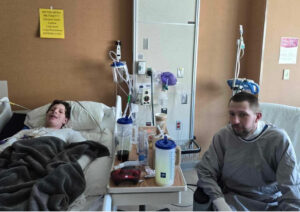 the car was engulfed in flames. The fireworks were on the floor at Tuckers feet, putting him in the worst possible place. Riley managed to pull the car over without hitting anything and began pulling the other boys out of the car. It was a lifesaving maneuver on his part, and while all the boys were burned, they were alive. The boys would spend differing lengths of time in the hospital, and have different treatments while they were there, with Tucker’s being the longest stay. Tucker also required much physical therapy to get the strength back in his legs. It’s been a long, hard road but Tucker was determined to get his life back, and he certainly did.
the car was engulfed in flames. The fireworks were on the floor at Tuckers feet, putting him in the worst possible place. Riley managed to pull the car over without hitting anything and began pulling the other boys out of the car. It was a lifesaving maneuver on his part, and while all the boys were burned, they were alive. The boys would spend differing lengths of time in the hospital, and have different treatments while they were there, with Tucker’s being the longest stay. Tucker also required much physical therapy to get the strength back in his legs. It’s been a long, hard road but Tucker was determined to get his life back, and he certainly did.
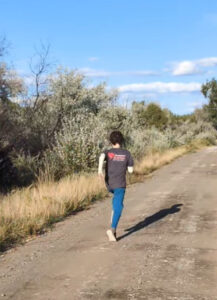
 Two months to the day, Tucker left the hospital…on his own steam. He was determined to come all the way back too, and so he has been working on running with those legs that no one was sure would walk again. He is back to school, and the Rocky Mountain High School and Middle School student council held a fund raiser called the T-shirt Game, and even made t-shirts that said Tucker Tuff. It was great to see everyone rallying around him like that, and I’m sure it inspired him to push forward in his healing process. Tucker is a strong guy, and I know he can do anything he sets his mind to. His future is bright, and I am so proud of him for sticking to it and making such an amazing come back for such a terrible accident. Today is Tucker’s 17th birthday. Happy birthday Tucker!! Have a great day!! We love you!!
Two months to the day, Tucker left the hospital…on his own steam. He was determined to come all the way back too, and so he has been working on running with those legs that no one was sure would walk again. He is back to school, and the Rocky Mountain High School and Middle School student council held a fund raiser called the T-shirt Game, and even made t-shirts that said Tucker Tuff. It was great to see everyone rallying around him like that, and I’m sure it inspired him to push forward in his healing process. Tucker is a strong guy, and I know he can do anything he sets his mind to. His future is bright, and I am so proud of him for sticking to it and making such an amazing come back for such a terrible accident. Today is Tucker’s 17th birthday. Happy birthday Tucker!! Have a great day!! We love you!!
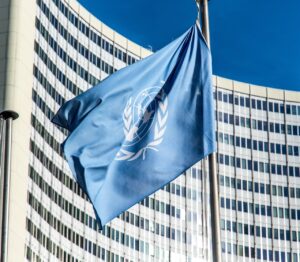
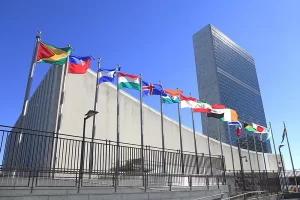 On October 24, 1945, the United Nations Charter, adopted and signed on June 26, 1945, came into effect. The United Nations (UN) emerged from a “perceived” need for a mechanism superior to the League of Nations in arbitrating international conflicts and negotiating peace. The escalating Second World War prompted the United States, Britain, and the Soviet Union to draft the initial UN Declaration, which 26 nations signed in January 1942 as an official stance against the Axis Powers of Germany, Italy, and Japan. It all seemed like a good idea, and perhaps was drafted with good intentions, but it is my opinion that the UN has failed miserably to accomplish any of the goals it set out to achieve.
On October 24, 1945, the United Nations Charter, adopted and signed on June 26, 1945, came into effect. The United Nations (UN) emerged from a “perceived” need for a mechanism superior to the League of Nations in arbitrating international conflicts and negotiating peace. The escalating Second World War prompted the United States, Britain, and the Soviet Union to draft the initial UN Declaration, which 26 nations signed in January 1942 as an official stance against the Axis Powers of Germany, Italy, and Japan. It all seemed like a good idea, and perhaps was drafted with good intentions, but it is my opinion that the UN has failed miserably to accomplish any of the goals it set out to achieve.
The foundational principles of the UN Charter were initially shaped during the San Francisco Conference, which began on April 25, 1945. This conference established the framework for a new international organization intended to “save succeeding generations from the scourge of war, to reaffirm faith in fundamental human rights, to establish conditions under which justice and respect for the obligations arising from treaties and other sources of international law can be maintained, and to promote social progress and better standards of life in larger freedom.” The Charter further outlined two additional vital goals. They were to maintain the principles of equal rights and self-determination for all peoples…initially intended to safeguard smaller nations at risk of being overtaken by the larger Communist powers emerging after the war, and to promote international collaboration to tackle worldwide economic, social, cultural, and humanitarian issues.
Following the war’s end, the responsibility of negotiating and maintaining peace was assigned to the newly established UN Security Council, which included the United States, Great Britain, France, the Soviet Union, and China. Each member possessed veto power. Winston Churchill implored the United Nations to employ its charter to promote a new, united Europe…a unity characterized by its opposition to communist expansion in both the East and the West. Yet, given the composition of the Security Council, achieving this proved more challenging than anticipated. I suppose that the distain felt by many people, for the United Nations, could have arisen from an impossible task, but more likely it came from flawed people who placed their own agenda ahead of the real needs of the people.
The United Nations is subject to criticism for a variety of reasons, including its policies, ideology, equality of representation, administrative practices, enforcement of decisions, and perceived ideological biases. Critics often cite a lack of success within the organization, noting failures in both preventative measures and in de-escalating conflicts ranging from social disputes to full-blown wars. Additional criticisms involve accusations of antisemitism, appeasement, collusion, promotion of globalism, inaction, and the exertion of undue influence by 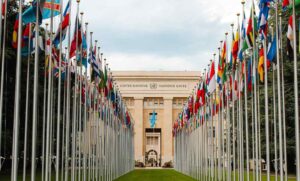
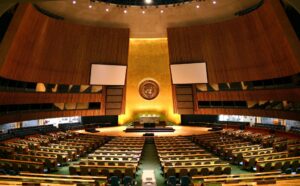 powerful nations within the General Assembly, as well as corruption and misallocation of resources. In my opinion, and that of many other people, that the UN should be dissolved, or at the very least, that the United States should withdraw and expel the United Nations from this nation. While some may disagree, this is my viewpoint.
powerful nations within the General Assembly, as well as corruption and misallocation of resources. In my opinion, and that of many other people, that the UN should be dissolved, or at the very least, that the United States should withdraw and expel the United Nations from this nation. While some may disagree, this is my viewpoint.
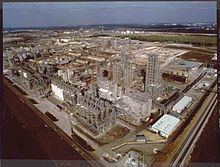 There is really no good reason to ever compromise on the safety procedures in a plant. People often think that it’s not that important to follow every safety procedure, every time…until something goes wrong. Then, they know the purpose of the safety procedures. On October 23, 1989, 23 people lost their lives in a series of explosions sparked by an ethylene leak at a factory in Pasadena, Texas. It was determined that the blasts, which took place at a Phillips Petroleum Company plant, were caused by inadequate safety procedures.
There is really no good reason to ever compromise on the safety procedures in a plant. People often think that it’s not that important to follow every safety procedure, every time…until something goes wrong. Then, they know the purpose of the safety procedures. On October 23, 1989, 23 people lost their lives in a series of explosions sparked by an ethylene leak at a factory in Pasadena, Texas. It was determined that the blasts, which took place at a Phillips Petroleum Company plant, were caused by inadequate safety procedures.
The Phillips 66 Chemical Complex in Pasadena houses a polyethylene reactor that synthesizes essential chemical compounds for plastic production. This facility generates millions of pounds of plastic each day, which are then utilized in manufacturing toys and various containers. Always looking to better their bottom line, Phillips outsourced a significant portion of the plant’s essential maintenance work to reduce expenses. Fish Engineering and Construction, the main subcontractor, already had a less-than-exemplary reputation before the disaster on 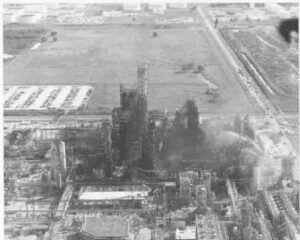 October 23rd. Previously, in August, a Fish worker-initiated maintenance on gas piping without isolating it, leading to the release of flammable solvents and gas into a work area. The resulting ignition caused the death of one employee and injuries to four others.
October 23rd. Previously, in August, a Fish worker-initiated maintenance on gas piping without isolating it, leading to the release of flammable solvents and gas into a work area. The resulting ignition caused the death of one employee and injuries to four others.
Then, at 1:05pm, on October 23rd, during maintenance work on the plant’s polyethylene reactor, issues emerged once more. A valve was improperly secured, leading to the release of 85,000 pounds of highly flammable ethylene-isobutane gas into the plant around 1pm. The absence of detectors or warning systems failed to alert anyone of the looming catastrophe. In under two minutes, the vast gas cloud exploded with the force equivalent to two-and-a-half tons of dynamite. The blast was heard for miles in every direction, and the ensuing fireball could be seen from at least 15 miles away. At Phillips, twenty-three workers lost their lives and an additional 130 sustained serious injuries when the initial explosion triggered a series of subsequent explosions.
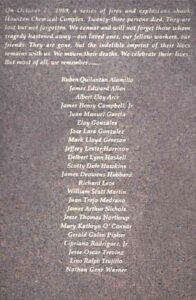 The initial emergency response came from the Phillips Petroleum Company’s fire brigade, who were quickly supported by the Channel Industries Mutual Aid (CIMA) team. Collaborating governmental entities included the Texas Air Control Board, Harris County Pollution Control, the Federal Aviation Administration (FAA), the US Coast Guard, the Occupational Safety and Health Administration (OSHA), and the US Environmental Protection Agency (EPA).
The initial emergency response came from the Phillips Petroleum Company’s fire brigade, who were quickly supported by the Channel Industries Mutual Aid (CIMA) team. Collaborating governmental entities included the Texas Air Control Board, Harris County Pollution Control, the Federal Aviation Administration (FAA), the US Coast Guard, the Occupational Safety and Health Administration (OSHA), and the US Environmental Protection Agency (EPA).
Investigation of the disaster revealed that despite the Occupational Safety and Health Administration (OSHA) citing Phillips for multiple serious safety violations in the past, a comprehensive inspection of the plant had not been conducted since 1975. Testimonies also uncovered that the plant was susceptible to disaster due to insufficient safety measures during maintenance. Nevertheless, even knowing all that, Phillips and its managers were never required to face criminal charges.

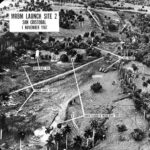 Each American presidency is marked by a defining moment, an event that encapsulates its tenure. For John F. Kennedy’s presidency, the Cuban Missile Crisis stood as that pivotal event. The most intense phase of the crisis, often referred to as the “13 Days,” spanned from October 16, 1962, when President Kennedy was informed of the Soviet missile sites being built in Cuba, to October 28, 1962, when Soviet Premier Nikita Khrushchev declared the dismantling of the missiles. On October 22, 1962, when it came time to tell the American people about the situation, President Kennedy revealed in a televised address of profound significance, that American spy planes had detected Soviet missile bases in Cuba. This represented a very dangerous situation for the United States. The missile sites were still under construction, but they were close to completion, and they contained medium-range missiles with the capacity to hit several major US cities, including Washington DC.
Each American presidency is marked by a defining moment, an event that encapsulates its tenure. For John F. Kennedy’s presidency, the Cuban Missile Crisis stood as that pivotal event. The most intense phase of the crisis, often referred to as the “13 Days,” spanned from October 16, 1962, when President Kennedy was informed of the Soviet missile sites being built in Cuba, to October 28, 1962, when Soviet Premier Nikita Khrushchev declared the dismantling of the missiles. On October 22, 1962, when it came time to tell the American people about the situation, President Kennedy revealed in a televised address of profound significance, that American spy planes had detected Soviet missile bases in Cuba. This represented a very dangerous situation for the United States. The missile sites were still under construction, but they were close to completion, and they contained medium-range missiles with the capacity to hit several major US cities, including Washington DC.
Kennedy declared he was imposing a naval “quarantine” on Cuba to block Soviet ships from delivering additional offensive weapons to the island. He stated that the United States would not accept the current missile sites’ presence. The president emphasized that America was prepared to take military action to eliminate what he described as a “secretive, irresponsible, and provocative threat to global peace.”
The Cuban Missile Crisis, as it became known, began on October 14, 1962, when US intelligence, analyzing data from a U-2 spy plane, discovered that the Soviet Union was constructing medium-range missile sites in Cuba. The following day, President Kennedy convened a secret emergency meeting with his top military, political, and diplomatic advisers to address the grave situation. This group came to be known as ExComm, an abbreviation for Executive Committee. Opting against a surgical air strike on the missile sites, ExComm instead chose a naval blockade and demanded the dismantling and removal of the missiles. It was then, on the evening of October 22, that President Kennedy disclosed his decision on national television. Tensions continued to mount over the ensuing six days, to a critical point, and placing the world on the edge of nuclear warfare between the two superpowers.
On October 23, the United States initiated a naval “quarantine” of Cuba. However, President Kennedy opted to allow Soviet Premier Nikita Khrushchev additional time to contemplate the US maneuver by moving the quarantine line back 500 miles. By October 24, Soviet vessels bound for Cuba, capable of transporting military cargo, seemed to have decelerated, changed course, or turned around as they neared the quarantine zone, except for one ship…the tanker Bucharest. Following appeals from over 40 nonaligned countries, UN Secretary-General U Thant made private overtures to Kennedy and Khrushchev, imploring their administrations to “avoid any actions that might worsen the situation and pose a risk of war.” Under orders from the Joint Chiefs of Staff, United States armed forces escalated to DEFCON 2, the most critical military readiness level ever achieved in the postwar period, while commanders readied for an all-out conflict with the Soviet Union.
On October 25, the aircraft carrier USS Essex and the destroyer USS Gearing tried to intercept the Soviet tanker Bucharest as it breached the US quarantine of Cuba. The Soviet vessel did not comply, but the US Navy refrained from taking it by force, judging that it was unlikely to be carrying offensive weapons. On October 26, Kennedy was informed that construction on the missile bases continued unabated, and ExComm contemplated a US invasion of Cuba. The Soviets apparently felt the tension of their actions, because on that same day, they offered a deal to resolve the crisis: they would dismantle the missile bases in return for a United States guarantee not to invade Cuba.
The following day, Khrushchev escalated the situation by publicly demanding the removal of US missile bases in Turkey, influenced by Soviet military leaders. As Kennedy and his advisors deliberated over this perilous shift in negotiations, a U-2 spy plane was downed over Cuba, resulting in the death of its pilot, Major Rudolf Anderson. It looked like thing might have reached the boiling point, but despite the Pentagon’s dismay, Kennedy prohibited any military response unless further surveillance aircraft were targeted over Cuba. To alleviate the intensifying crisis, Kennedy and his team decided to dismantle the US missile installations in Turkey at a subsequent time, to avoid provoking Turkey, who was an essential NATO ally.
On October 28, Khrushchev declared his government’s decision to dismantle and remove all offensive Soviet weapons from Cuba. Following the broadcast of this public announcement on Radio Moscow, the USSR affirmed its readiness to adopt the resolution secretly suggested by the Americans the previous day. That afternoon, Soviet technicians started dismantling the missile sites, averting the imminent threat of nuclear war. The Cuban Missile Crisis had effectively ended. In November, Kennedy lifted the blockade, and by year’s end, all offensive missiles were removed from Cuba. Later, the United States discreetly withdrew its missiles from Turkey.
At the time, the Cuban Missile Crisis appeared to be a definitive triumph for the United States. In this, Cuba gained a heightened sense of security following the crisis. The withdrawal of obsolete Jupiter missiles from Turkey did not negatively impact the United States’ nuclear strategy. Nevertheless, the crisis spurred the USSR, feeling humiliated, to initiate a substantial nuclear arms expansion. By the 1970s, the Soviet Union had achieved nuclear parity with the United States and developed intercontinental ballistic missiles with the capability to target any city within the United States.
The presidents that followed Kennedy upheld his promise to refrain from invading Cuba, and the relationship with the communist nation, located a mere 80 miles off the coast of Florida, continued to challenge United States foreign policy for over half a century. Finally, in 2015, representatives from both countries declared the official normalization of United States-Cuba relations, encompassing the relaxation of travel bans and the establishment of embassies and diplomatic offices in each nation.
For Kennedy, this pivotal moment in his administration showcased his ability to manage a high-stakes international crisis. His decision to implement a naval blockade and negotiate with Soviet Premier Nikita Khrushchev helped avoid a potential nuclear war. It also demonstrated his leadership and diplomatic skills, as he balanced military readiness with diplomatic negotiations, which ultimately led to the removal of Soviet missiles from Cuba. The successful resolution of the crisis significantly boosted Kennedy’s public image, portraying him as a strong and capable leader who could protect the United States from external threats. The crisis was a defining moment in the Cold War, highlighting the intense rivalry between the United States and the 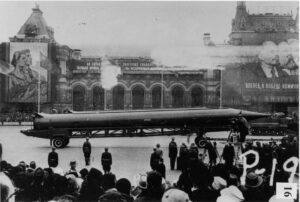
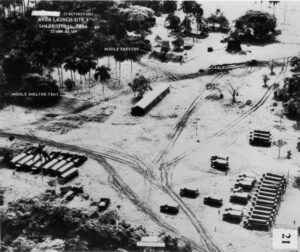 Soviet Union. Nevertheless, it also led to the establishment of a direct communication line between Washington and Moscow, known as the “hotline,” to prevent future crises. In summary, the Cuban Missile Crisis was a defining event that not only tested Kennedy’s presidency, but it also shaped his legacy as a leader who could navigate the complexities of international relations during one of the most dangerous periods of the Cold War.
Soviet Union. Nevertheless, it also led to the establishment of a direct communication line between Washington and Moscow, known as the “hotline,” to prevent future crises. In summary, the Cuban Missile Crisis was a defining event that not only tested Kennedy’s presidency, but it also shaped his legacy as a leader who could navigate the complexities of international relations during one of the most dangerous periods of the Cold War.
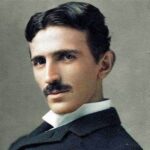 Sometimes, in the minds of geniuses, ideas can become lost or even stolen when the genius lacks the patience to promote their inventions to the world. They have innovated minds, but the marketing, patents, and mass-producing part is boring to them. Nikola Tesla, who was born on July 10, 1856, was such a scientist. Tesla was of Serbian nationality in Smiljan, within the Austrian Empire. He was considered one of the greatest and most enigmatic contributors to the development of electromagnetism and various scientific advancements of his era. Despite his impressive array of patents and discoveries, his contributions were frequently overshadowed during his life.
Sometimes, in the minds of geniuses, ideas can become lost or even stolen when the genius lacks the patience to promote their inventions to the world. They have innovated minds, but the marketing, patents, and mass-producing part is boring to them. Nikola Tesla, who was born on July 10, 1856, was such a scientist. Tesla was of Serbian nationality in Smiljan, within the Austrian Empire. He was considered one of the greatest and most enigmatic contributors to the development of electromagnetism and various scientific advancements of his era. Despite his impressive array of patents and discoveries, his contributions were frequently overshadowed during his life.
Nikola Tesla, a gifted student, attended the Austrian Polytechnic in Graz in 1875. He later moved to secure a job in Marburg, Slovenia. His challenging disposition occasionally surfaced, leading to a falling out with his family and a subsequent nervous breakdown. It is said that Tesla had an IQ of somewhere between 160 and 310 or “off the charts.” That makes it entirely possible that Tesla suffered with many mood swings. After leaving Slovenia, he registered at Charles Ferdinand University in Prague, only to leave once more without finishing his degree.
In his early years, he went through numerous bouts of sickness and bursts of striking inspiration. He frequently had visions of mechanical and theoretical inventions, often accompanied by intense flashes of light. His ability to visualize images in his mind was extraordinary. Instead of drafting plans or scale drawings for his projects, he depended on the vivid images in his imagination.
In 1880, he relocated to Budapest to work for a telegraph company. It was there that he familiarized himself 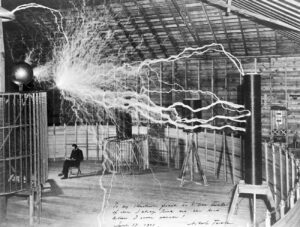 with twin turbines and contributed to the development of a device that amplified telephone signals. In 1882, he transferred to Paris to join the Continental Edison Company. During his tenure, he enhanced several Edison devices and devised the induction motor and other apparatuses utilizing rotating magnetic fields. Then, armed with a strong recommendation letter, Tesla arrived in the United States in 1884 to join the Edison Machine Works. There, he quickly rose to become a chief engineer and designer. Tasked with enhancing the direct current generators’ electrical system, Tesla was allegedly promised $50,000 for significant improvements. Despite fulfilling his task, Tesla was apparently not compensated, fueling a profound rivalry and resentment towards Thomas Edison. This animosity became a hallmark of Tesla’s life, affecting his financial standing and reputation. The intense feud is also cited as a contributing factor to why neither Tesla nor Edison received the Nobel Prize for their contributions to electrical engineering.
with twin turbines and contributed to the development of a device that amplified telephone signals. In 1882, he transferred to Paris to join the Continental Edison Company. During his tenure, he enhanced several Edison devices and devised the induction motor and other apparatuses utilizing rotating magnetic fields. Then, armed with a strong recommendation letter, Tesla arrived in the United States in 1884 to join the Edison Machine Works. There, he quickly rose to become a chief engineer and designer. Tasked with enhancing the direct current generators’ electrical system, Tesla was allegedly promised $50,000 for significant improvements. Despite fulfilling his task, Tesla was apparently not compensated, fueling a profound rivalry and resentment towards Thomas Edison. This animosity became a hallmark of Tesla’s life, affecting his financial standing and reputation. The intense feud is also cited as a contributing factor to why neither Tesla nor Edison received the Nobel Prize for their contributions to electrical engineering.
Disappointed by the lack of a pay raise, Tesla resigned and briefly worked digging ditches for the Edison telephone company. In 1886, he established his own company, which failed due to his investors’ lack of faith in alternating current (AC). The following year, Tesla experimented with a type of X-Ray technology, managing to photograph the bones in his hand and recognizing the harmful side-effects of radiation. Despite this, his work received minimal attention, and much of his research was destroyed in a fire at a New York warehouse.
Nikola Tesla was renowned for his intense work ethic and dedication to his work. He often dined alone and 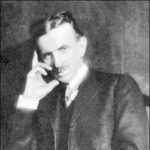 seldom slept, sometimes only two hours per day. He never married, believing that his celibacy was beneficial to his scientific pursuits. In his later years, he adopted a vegetarian diet, subsisting solely on milk, bread, honey, and vegetable juices. In his lifetime, Tesla can be credited with many inventions, among them, the Tesla coil: A system for wireless transmission of electricity; the Tesla turbine: A type of turbine; the radio: Tesla demonstrated radio communication before Marconi; the Magnifying transmitter: A device for wireless energy transmission; and the Induction motor: A key component in modern devices. Tesla died on January 7, 1943, in a hotel room in New York City at the age of 86. After his death, in 1960 the General Conference on Weights and Measures named the SI unit of magnetic field strength the Tesla in his honor.
seldom slept, sometimes only two hours per day. He never married, believing that his celibacy was beneficial to his scientific pursuits. In his later years, he adopted a vegetarian diet, subsisting solely on milk, bread, honey, and vegetable juices. In his lifetime, Tesla can be credited with many inventions, among them, the Tesla coil: A system for wireless transmission of electricity; the Tesla turbine: A type of turbine; the radio: Tesla demonstrated radio communication before Marconi; the Magnifying transmitter: A device for wireless energy transmission; and the Induction motor: A key component in modern devices. Tesla died on January 7, 1943, in a hotel room in New York City at the age of 86. After his death, in 1960 the General Conference on Weights and Measures named the SI unit of magnetic field strength the Tesla in his honor.
 There are phenomena that sometimes manifest in the sky seem supernatural, although scientists often have other explanations. I rather think they are supernatural…as in coming from God. Such occurrences were first reported by mountain climbers before the era when airplane travel was common. I’m sure they still see them today too. Climbers would reach a mountain’s summit and suddenly see what seemed to be a figure standing in the distance. I must admit that such a sight would be a little disconcerting, but I wouldn’t mind seeing one. In the mid-1700s, members of a French scientific expedition ascended Pambamarca, a mountain in Ecuador. It seemed like a normal ascent, but when they reached its peak, they witnessed the sun breaking through the clouds, casting their shadows and encircling their heads with halo-like rings. Maybe that is how it happens, but I would say that the conditions would have to be exactly right for this to happen, and I think that is God. I can only imagine their thoughts at that moment…probably fear mixed with curiosity.
There are phenomena that sometimes manifest in the sky seem supernatural, although scientists often have other explanations. I rather think they are supernatural…as in coming from God. Such occurrences were first reported by mountain climbers before the era when airplane travel was common. I’m sure they still see them today too. Climbers would reach a mountain’s summit and suddenly see what seemed to be a figure standing in the distance. I must admit that such a sight would be a little disconcerting, but I wouldn’t mind seeing one. In the mid-1700s, members of a French scientific expedition ascended Pambamarca, a mountain in Ecuador. It seemed like a normal ascent, but when they reached its peak, they witnessed the sun breaking through the clouds, casting their shadows and encircling their heads with halo-like rings. Maybe that is how it happens, but I would say that the conditions would have to be exactly right for this to happen, and I think that is God. I can only imagine their thoughts at that moment…probably fear mixed with curiosity.
The mountain tops are not the only place this has been seen. Now that we are in the era of travel by planes, passengers gazing out of airplane windows have observed not just the aircraft’s shadow but also a rainbow ring encircling it, resembling a halo. Again, scientists have a tendency to explain this away, but I believe rainbows come from God. The phenomenon is known as a glory, pilot’s glory, or pilot’s halo. This phenomenon is not caused by the plane’s shadow itself but often appears alongside it, hence the name. That is part of the reason I don’t think it is an optical illusion. If it is, why don’t more people see it, more often?
A German physicist in the early 1900s, named Gustav Mie, went so far as to develop a mathematical formula to describe the scattering of light by water droplets in the air. I can’t imagine what mathematics would have to do with it, but the thought captivated him anyway. According to an article in the Bulletin of the American Meteorological Society, “glories are produced by the backscattering, or angular deflection, of sunlight by minuscule water droplets in the atmosphere—droplets so small they measure just tens of wavelengths in diameter.” Scientists believe that the size of the rings varies with different wavelengths of light, depending on the average diameter of the droplets and their distribution. To observe a glory, one must be positioned directly between the light source and the water droplets, which explains why glories often appear alongside shadows. That’s where I start to think things would have to be a “little bit too perfect” for this to be coincidence.
Mie’s mathematics did not fully account for the workings of glories…little wonder there. In the 1980s, Nussenzveig and NASA scientist Warren Wiscombe discovered that the light contributing to a glory often does 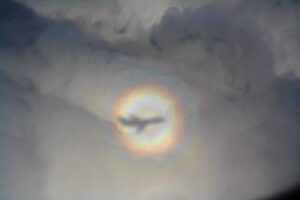
 not pass through the droplets. A 2014 article in Nature magazine believes that wave tunneling is primarily responsible for glories. This process supposedly occurs when sunlight comes close enough to a droplet to induce electromagnetic waves inside it. These waves circulate within the droplet before escaping, emitting the light rays that form the bulk of the glory observed. Believe what you want, but I think that these are little gifts from God.
not pass through the droplets. A 2014 article in Nature magazine believes that wave tunneling is primarily responsible for glories. This process supposedly occurs when sunlight comes close enough to a droplet to induce electromagnetic waves inside it. These waves circulate within the droplet before escaping, emitting the light rays that form the bulk of the glory observed. Believe what you want, but I think that these are little gifts from God.
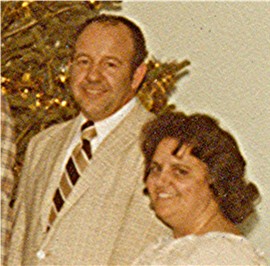
 My uncle, Jim Richards is a “teddy bear” of a man who is loved by all who know him. I say “teddy bear” because he has the personality of what we would expect a “teddy bear” to have. He is kind and caring and he would give you the shirt off his back, if you needed one. I don’t think he has ever had an enemy in his life. Uncle Jim is always soft-spoken and quiet…and maybe just a little bit shy.
My uncle, Jim Richards is a “teddy bear” of a man who is loved by all who know him. I say “teddy bear” because he has the personality of what we would expect a “teddy bear” to have. He is kind and caring and he would give you the shirt off his back, if you needed one. I don’t think he has ever had an enemy in his life. Uncle Jim is always soft-spoken and quiet…and maybe just a little bit shy.
My aunt, Sandy Pattan (Aunt Dixie’s younger sister) and I, along with my sister Caryl have gone to visit recently, and it has been so fun to spend some time with the Richards family. Whenever we go to visit, Uncle Jim is happy to “give the women their space” by setting himself up in front of the television watching sports. I’m sure that all the girl talk going on in the dining room would be boring to Uncle Jim anyway. Watching sports is much more to his liking. He loves the Broncos, but they aren’t always playing. I don’t think it really matters to him, any football game works…when the Broncos aren’t playing. If the Broncos are playing, Uncle Jim is going to be watching.
Uncle Jim is and always was a family man. His family is his top priority, and they feel the same way about him. They are a close family. Uncle Jim and Aunt Dixie live with their daughter Jeannie Liegman and her son Jacob, but daughter Raylynn Williams, her husband Doug, and children Gabriel, Gideon, Noah, and Mayme live across the road. Meals are together as a family. It really makes the family close. Uncle Jim and Aunt Dixie have always been willing to help out family members when needed, whether it was his family or her family, they were there for them, even taking in extras over the years. They never lost that sense of family loyalty, and that is a great 
 testament to their kind and loving hearts. Uncle Jim lost his dad at a young age, and he took on much of the roll of man of the house from that time on…and he was just one month shy of nine years old. He wasn’t the oldest child either, he just knew what was needed, and he did it. His whole family looked to him for guidance many times. That shows that he possessed wisdom beyond his young years. That is amazing and I highly respect his caring ways toward his family in their times of need. Today is Uncle Jim’s 87th birthday. Happy birthday Uncle Jim!! Have a great day!! We love you!!
testament to their kind and loving hearts. Uncle Jim lost his dad at a young age, and he took on much of the roll of man of the house from that time on…and he was just one month shy of nine years old. He wasn’t the oldest child either, he just knew what was needed, and he did it. His whole family looked to him for guidance many times. That shows that he possessed wisdom beyond his young years. That is amazing and I highly respect his caring ways toward his family in their times of need. Today is Uncle Jim’s 87th birthday. Happy birthday Uncle Jim!! Have a great day!! We love you!!


